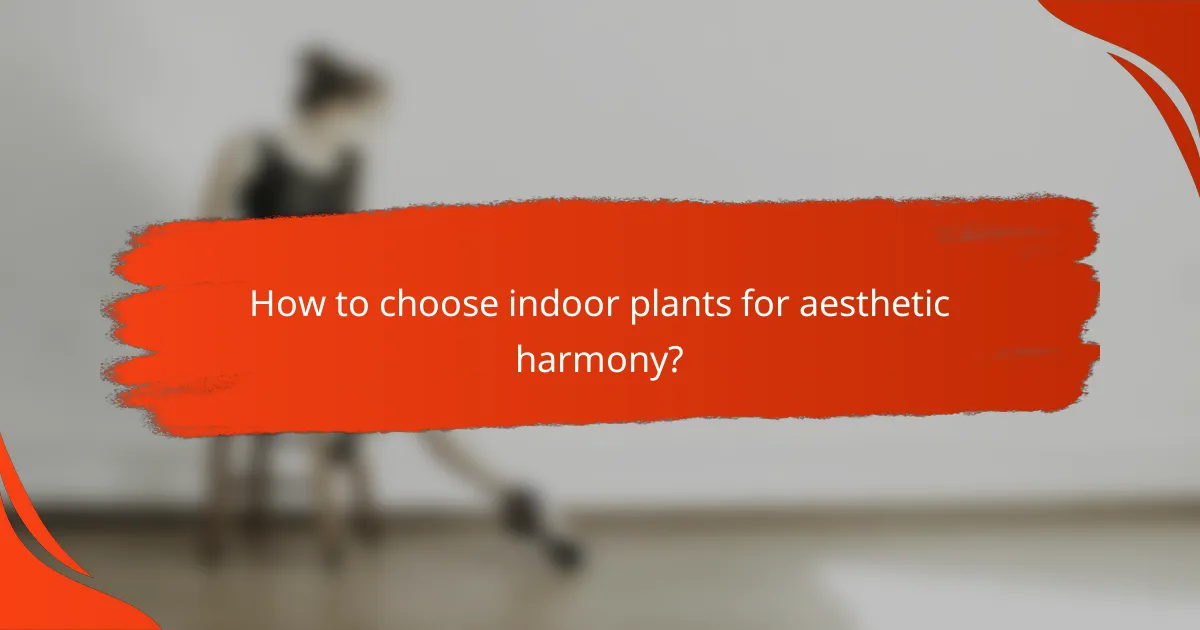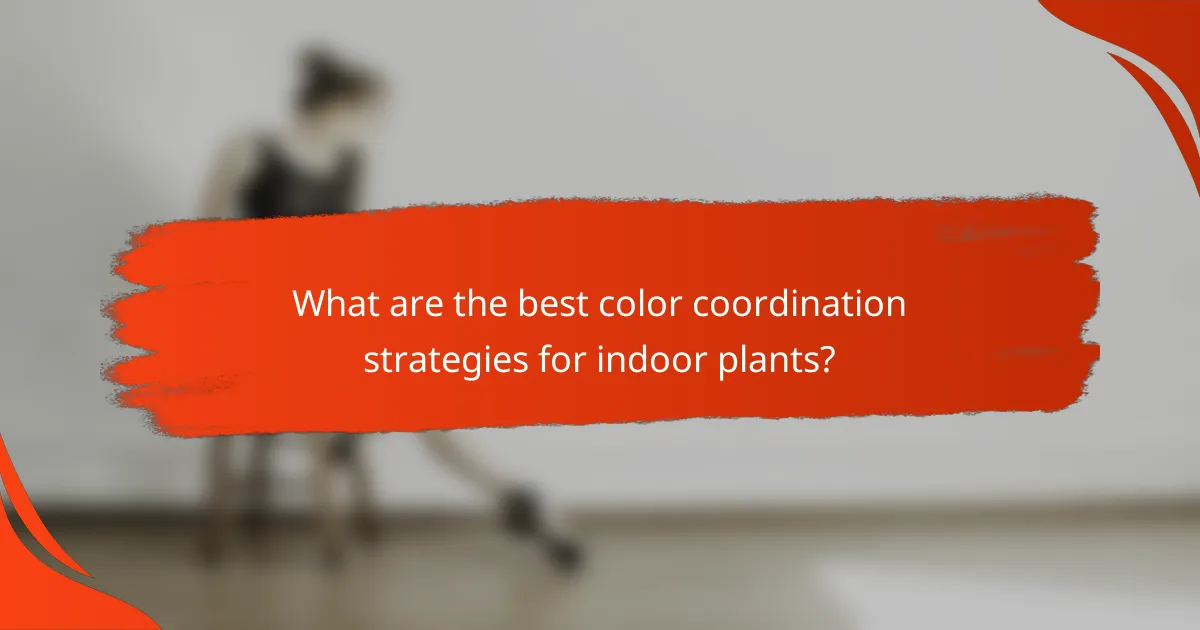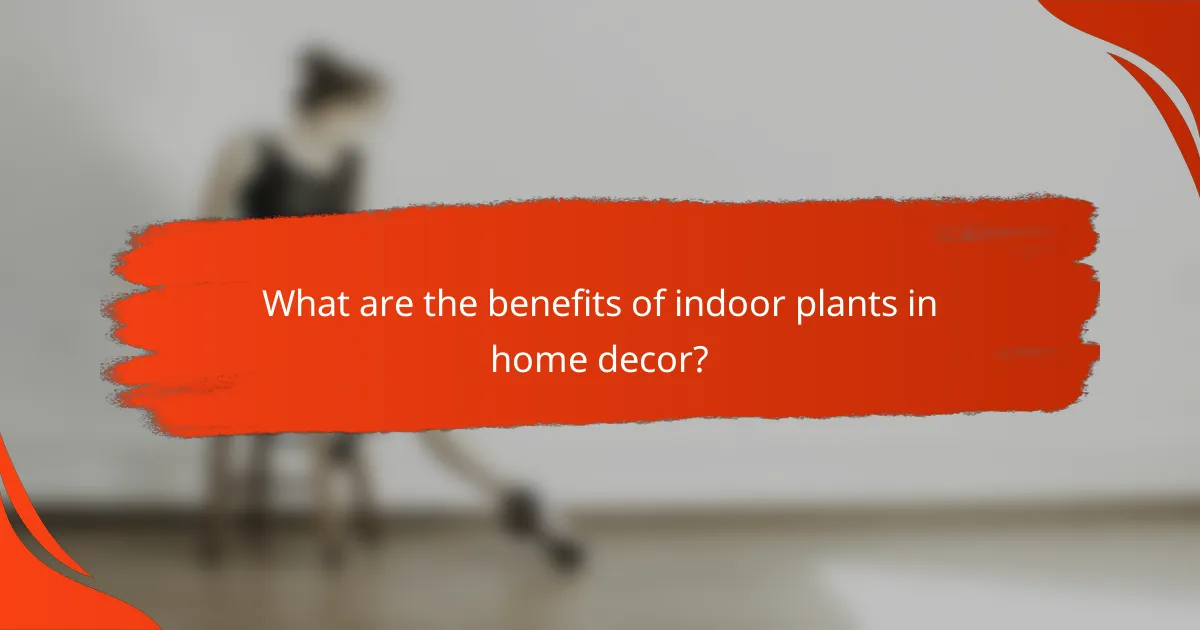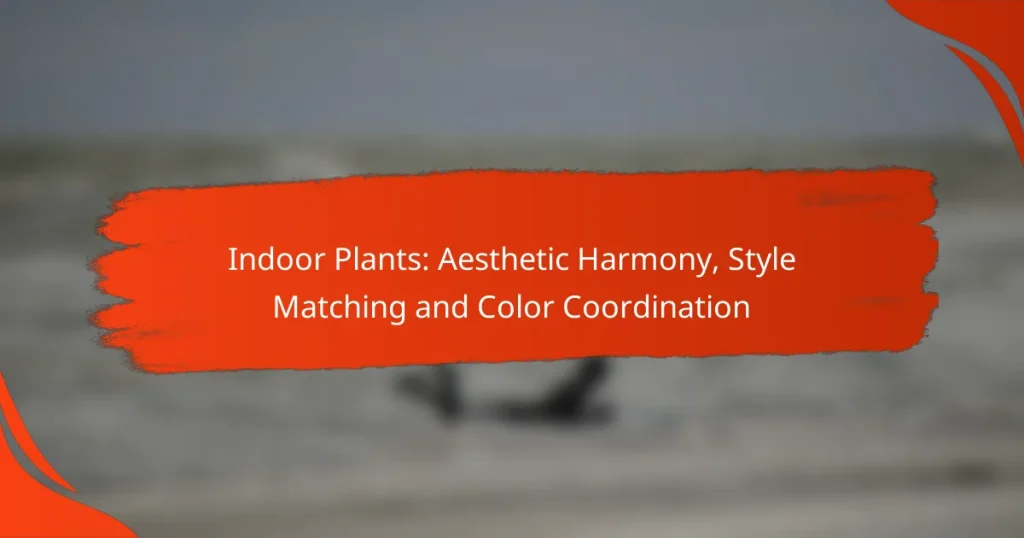Indoor plants play a vital role in achieving aesthetic harmony within your living space by complementing your decor style and color scheme. By carefully selecting species based on size, shape, and maintenance needs, you can enhance the overall ambiance of your home. Additionally, effective color coordination can elevate your interior design, creating a cohesive environment that showcases the beauty of your plants.

How to choose indoor plants for aesthetic harmony?
Choosing indoor plants for aesthetic harmony involves selecting species that complement your space’s style, color scheme, and overall ambiance. Consider factors such as size, shape, color, light availability, and maintenance needs to create a cohesive look.
Consider plant size and shape
The size and shape of indoor plants significantly influence the visual balance of a room. Tall plants like fiddle leaf figs can create height, while low-growing succulents add subtlety. Aim for a mix of sizes to create depth and interest.
When placing plants, consider their growth habits. For instance, trailing plants like pothos can soften vertical spaces, while upright plants can serve as focal points. Grouping plants of varying heights can enhance the overall aesthetic.
Match colors with room decor
Color coordination between plants and room decor is essential for aesthetic harmony. Choose plants with foliage that complements or contrasts with your existing color palette. For example, vibrant green leaves can brighten a neutral space, while deep burgundy plants can add richness to a colorful room.
Consider the pot colors as well. Neutral pots can blend seamlessly into any decor, while colorful pots can serve as statement pieces. Ensure that the plant colors and pot styles align with the room’s theme for a unified look.
Assess light conditions
Light conditions play a crucial role in plant selection for aesthetic harmony. Different plants have varying light requirements, from low-light tolerant species like snake plants to sun-loving varieties like succulents. Assess the natural light in your space before choosing plants.
Use sheer curtains or strategically placed mirrors to enhance light if needed. This can help create a more suitable environment for your chosen plants, ensuring they thrive while contributing to the room’s aesthetic appeal.
Evaluate maintenance requirements
Maintenance requirements are vital to consider when selecting indoor plants for aesthetic harmony. Some plants need frequent watering and care, while others are low-maintenance and can thrive with minimal attention. Choose plants that fit your lifestyle to maintain their beauty over time.
For busy individuals, consider hardy plants like ZZ plants or pothos, which require less care. On the other hand, if you enjoy gardening, you might opt for more demanding species that allow for creative expression through care and styling.

Which indoor plants enhance style matching?
Indoor plants can significantly enhance style matching by complementing various interior design themes. Selecting the right plants not only adds aesthetic appeal but also creates a cohesive look that aligns with your decor style.
Fiddle Leaf Fig for modern decor
The Fiddle Leaf Fig is a popular choice for modern decor due to its large, glossy leaves and sculptural form. It works well in contemporary spaces, providing a bold statement that can elevate the overall design.
When incorporating a Fiddle Leaf Fig, consider placing it in a bright location with indirect sunlight. This plant thrives in well-draining soil and requires moderate watering, making it relatively easy to care for while maintaining its striking appearance.
Snake Plant for minimalist spaces
The Snake Plant, known for its upright, architectural leaves, is ideal for minimalist spaces. Its clean lines and low-maintenance nature make it a perfect fit for those who prefer simplicity without sacrificing style.
This plant tolerates low light and infrequent watering, making it a practical choice for busy individuals. Position it in a sleek pot that matches your decor to enhance its visual impact while keeping the space uncluttered.
Pothos for bohemian aesthetics
Pothos plants are excellent for bohemian aesthetics, thanks to their trailing vines and vibrant green leaves. They add a touch of whimsy and natural beauty, making them a favorite among those who embrace a relaxed, eclectic style.
To showcase Pothos effectively, consider hanging them in macramé planters or placing them on shelves where their vines can cascade down. They thrive in various lighting conditions and require minimal care, making them an ideal choice for creating a lush, inviting atmosphere.

What are the best color coordination strategies for indoor plants?
Effective color coordination for indoor plants enhances the overall aesthetic of a space. By understanding complementary, analogous, and neutral color strategies, you can create a harmonious environment that highlights your plants’ beauty.
Complementary color schemes
Complementary color schemes involve pairing colors that are opposite each other on the color wheel, such as green plants with red or purple decor. This contrast draws attention and creates a vibrant look. For example, a green fern can stand out beautifully against a deep red wall.
When using complementary colors, consider the intensity of the hues. Bright colors can energize a space, while muted tones may create a more subdued atmosphere. Aim for a balance that suits your personal style and the mood you want to establish.
Analogous color pairings
Analogous color pairings consist of colors that are next to each other on the color wheel, like green, blue-green, and blue. This approach creates a serene and cohesive look, ideal for spaces meant for relaxation. For instance, pairing a jade plant with blue decor can evoke a calming ambiance.
To implement this strategy, select one dominant color and use the adjacent shades to complement it. This method works well in larger spaces where multiple plants can be grouped together, enhancing the overall visual flow.
Neutral tones for balance
Neutral tones, such as whites, grays, and browns, provide a grounding effect that allows colorful plants to shine. Using neutral backgrounds or pots can help highlight the vibrant greens and blooms of your indoor plants. For example, a white ceramic pot can accentuate the lush foliage of a snake plant.
When incorporating neutral tones, ensure they harmonize with your existing decor. This strategy is particularly effective in minimalist designs, where the focus remains on the plants themselves. Avoid overly busy patterns that can distract from the natural beauty of your greenery.

How to create a cohesive indoor plant arrangement?
Creating a cohesive indoor plant arrangement involves selecting plants that complement each other in height, texture, and pot design. This thoughtful combination enhances the aesthetic appeal of your space while ensuring a harmonious look.
Group plants by height
Arranging plants by height helps create visual interest and balance. Taller plants can serve as focal points, while shorter ones can fill in gaps and provide a layered effect. For instance, place a tall fiddle leaf fig next to medium-sized snake plants and smaller succulents.
When grouping, consider the overall space. In a small room, use a mix of low and medium-height plants to avoid overwhelming the area. In larger spaces, you can incorporate taller plants to draw the eye upward and create a sense of depth.
Use varied textures
Incorporating plants with different textures adds richness to your arrangement. For example, combine the smooth leaves of a rubber plant with the feathery fronds of a fern and the spiky appearance of an aloe vera. This contrast enhances visual appeal and keeps the arrangement dynamic.
To achieve a balanced look, aim for a mix of soft, glossy, and rough textures. This variety can evoke a more natural feel, making the indoor garden inviting and engaging. Avoid using too many similar textures, which can make the arrangement appear flat.
Incorporate decorative pots
Decorative pots play a crucial role in tying your indoor plant arrangement together. Choose pots that complement the style of your plants and the overall decor of the room. For example, sleek ceramic pots work well in modern settings, while rustic terracotta pots suit more traditional spaces.
Consider the color and finish of the pots as well. Neutral colors can provide a calming backdrop, while vibrant hues can add a pop of color. Ensure that the pot size is appropriate for the plant, allowing for adequate growth and drainage.

What are the benefits of indoor plants in home decor?
Indoor plants enhance home decor by improving aesthetics and promoting a healthier living environment. They add color, texture, and life to spaces while also offering benefits like improved air quality and reduced stress levels.
Improved air quality
Indoor plants significantly contribute to improved air quality by filtering pollutants and increasing oxygen levels. Common houseplants like spider plants, peace lilies, and snake plants can absorb toxins such as formaldehyde and benzene, making the air healthier to breathe.
To maximize air purification, consider placing a variety of plants throughout your home, particularly in areas with poor ventilation. A general guideline is to have at least one plant per 100 square feet of space for optimal benefits.
However, be cautious with plant selection if you have pets or allergies, as some species can be toxic or trigger sensitivities. Always research plants before introducing them to your home environment.


